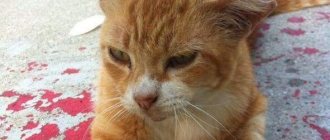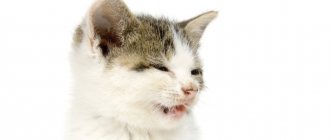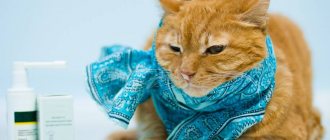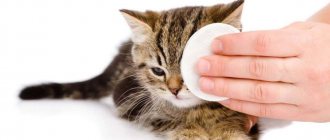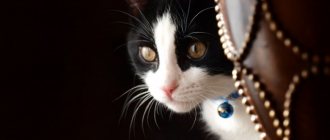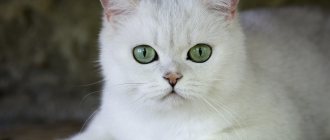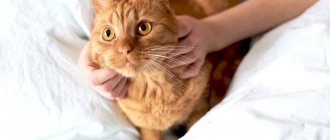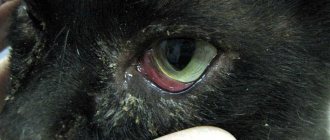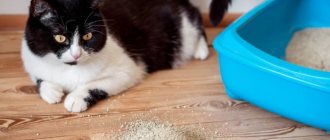Owners should be seriously concerned about the health of a cat who is sneezing and coughing, as well as if he has snot and watery eyes. Typically, these symptoms indicate respiratory diseases, inflammatory lesions of the nasal cavity and pharynx. Kittens with a cold often have sour eyes, black crusts appear in the nose and other signs of a particular illness develop, upon observing which it is better for the breeder to take the household member to the veterinarian and not self-medicate.
Why does a cat sneeze?
Sneezing in cats can be caused by unfavorable factors of various natures. For example, the sneeze reflex in animals is a reaction to the influence of any allergen that irritates the mucous membrane of the upper respiratory tract. The ingress of dust particles, pollen from flowering plants, and household chemicals irritate the receptors in the nasal mucosa, which is accompanied by sneezing.
The cat sneezes
Important! As a rule, sneezing in cats and other animals is caused by irritation of the nerve endings located on the mucous membrane of the respiratory tract.
Often, sneezing can be a symptom of a respiratory illness. A common runny nose, as a rule, is always accompanied by a reflexive sneezing reflex. Thus, the animal’s body clears the respiratory tract from accumulated exudate.
recommended articles:
- Pneumonia in cats
- Antiviral drugs for cats
Cats, cats, kittens sneeze when:
- asthma;
- colds;
- viral, bacterial, fungal infections;
- the presence of polyps in the nose;
- neoplasms in the respiratory tract, upper respiratory tract;
- severe hypothermia;
- congenital pathologies, anatomical defects in the structure of the respiratory organs;
- chronic respiratory diseases (tonsillitis, rhinotracheitis, sinusitis);
- the presence of foreign objects in the larynx.
The sneezing reflex in cats can be triggered by sharp, pungent odors, for example, perfume, eau de toilette, air freshener, tobacco smoke. Molds that live on wall surfaces, congenital pathologies, and anatomical defects of the respiratory tract organs provoke sneezing attacks in cats.
Once in the upper respiratory tract, allergens of various nature irritate the mucous membranes and lead to frequent sneezing. Sneezing and sniffling in cats are often signs of seasonal allergies.
What are the types of nasal discharge?
The appearance of snot and its properties depend on many factors, including:
- type of inflammation;
- presence of bacteria in the secretion;
- mucus viscosity.
Normal mucus in a healthy animal flows out of the nasal passages due to the work of the cilia of the epithelium lining the mucosa. Normally liquid, during illness the discharge thickens, and its normal outflow is disrupted.
In such a rich nutrient medium, bacteria begin to multiply. And then the root cause - a virus or any other factor - is complicated by secondary microflora and is characterized by the development of purulent inflammation.
Let's consider what types of inflammation there are during a runny nose:
- catarrhal - characterized by the release of a large amount of transparent mucus (the cat constantly sneezes with snot, liquid and colorless);
- purulent - accompanied by the release of a thick, opaque secretion of white, yellow or green color, its saturation depends on how severe the stagnation has occurred in the nasal cavity and how many bacteria there are.
What is pus?
What is pus? It is nothing more than a mass of white blood cells and bacteria. With a strong degree of inflammation, this type of discharge occurs. Sometimes blood is mixed in with them - we discussed in detail the causes of nosebleeds of varying intensity in the article “The cat sneezes with blood.”
A small number of blood streaks in the secretion is not scary: they appear due to the dilation of blood vessels in the inflamed tissue.
As the pus dries, it becomes more viscous, turning into crusts and a semi-solid mass that clogs the nasal passages. All these processes prevent the cat from breathing normally and increase the recovery time.
Causes of snot
If sneezing is accompanied by a runny nose, mucous, and purulent discharge from the eyes, the symptoms do not go away within 7-10 days; rather, the reason for this condition lies in the development of infectious processes in the body of the pet. Sneezing, coughing, or rhinitis may indicate that your beloved cat is sick with parasitic, viral, or bacterial diseases.
One of the first manifestations of peritonitis, plague, calcivirosis, viral pneumonia, helminthic infestations, and other parasitic diseases is a runny nose, frequent sneezing, coughing, and serous-catarrhal discharge from the eyes.
The cat is sneezing, there is noticeable discharge from the eyes
A runny nose in cats, kittens, cats can occur against the background of allergic reactions, when foreign bodies or objects enter the respiratory tract. Nasal discharge can be: serous, catarrhal, purulent. In cases of chronic rhinitis, blood clotting disorders, and feline viral immunodeficiency, bloody threads, clots, and inclusions are noticeable in the discharge from the nose.
Green snot is a danger signal
Green snot signals the addition of bacterial microflora. It could be as follows:
- streptococci;
- staphylococci;
- Pseudomonas aeruginosa;
- pneumococci.
These are the main bacteria that cause your pet to snot. But there may be other pathogenic microorganisms. The green color is formed due to the proliferation of bacteria, the action of the immune system, which secretes lymphocytes and inflammatory mediators. The greater the immune response, the greater the swelling and exudate.
Gradually, rhinitis with green snot becomes more complicated, leading to the following diseases:
Purulent exudate can pass not only into the sinuses, but down the respiratory system. First, pharyngitis appears, which then develops into tracheitis, bronchitis and pneumonia. This condition is common, especially in cats with reduced immune reactivity.
Purulent exudate has a thick structure, so it often completely clogs the nasal passages. The pet begins to breathe heavily and snore in its sleep. In severe cases, body temperature rises.
In rare cases, the infection can travel throughout the body, causing infectious inflammation of the kidneys, bladder, and even the brain.
Attention! If antibacterial drugs are not given to the animal in a timely manner, bacteria can enter the bloodstream, causing sepsis and death without first aid.
What to do?
If your cat’s eyes are very watery, the general condition has worsened, and your pet begins to sneeze frequently, you should consult a veterinarian. The animal may have contracted an eye infection. In this case, it is necessary to treat the eyes with ophthalmic solutions, which can be purchased at a veterinary pharmacy, or rinse the eyes with decoctions of medicinal plants, for example, a warm infusion of chamomile flowers.
If your cat sneezes, snorts, or rubs his nose with his paw, there is most likely a foreign object in the nose. You can alleviate your pet's condition by using special tweezers or any other available means. All manipulations should be carried out extremely carefully so as not to hurt the cat or injure the mucous membrane.
The cat rubs its face with its paw
Having noticed mucous discharge from the nose, shortness of breath, difficulty breathing, swollen red eyes in a cat or kitten, it is necessary to establish the cause of this condition. Most likely, sneezing is caused by allergens. It is worth consulting with a veterinarian who will select a safe, most effective antihistamine.
Important! If blood or blood clots are released when sneezing, this may indicate the development of cancer or serious damage to the nasal passages.
Increased body temperature, enlarged submandibular lymph nodes, lethargy, decreased activity, refusal of food and treats, profuse nasal discharge are a serious cause for concern. Therefore, contact your veterinarian and take the cat to a veterinary hospital.
Fluffy patients with viral infections will be prescribed complex treatment, antibiotic therapy (Fosprenil, Maxidin), anti-inflammatory, antipyretic drugs. To normalize the general condition of furry purrs, vitamin complexes, mineral supplements, and immunomodulators will be prescribed.
Drops for the treatment of rhinitis
In case of a runny nose, the cat’s nasal passages are washed with hypotonic solutions, and the mucous membrane is irrigated with 0.5% tannin, galazolin, and thymogen.
If the sneezing reflex and snot are provoked by helminthic infestation, the cats will be prescribed effective helminthic drugs. For fungal infections - fungicidal, antifungal medications.
The veterinarian will prescribe effective treatment therapy
Sneezing caused by allergies is treated with antiallergic medications, special medicinal creams, and ointments. It is equally important to eliminate allergens from the cat’s external environment.
During treatment, owners must strictly follow all recommendations of the attending physician and provide the pet with the most comfortable living conditions. In case of respiratory diseases, it is absolutely unacceptable for the cat to be in a draft! Constantly remove discharge from the eyes and nose with sterile cotton-gauze swabs soaked in antiseptic solutions.
How to treat a runny nose in a cat?
If allergy
In order to remove the symptoms of a runny nose, sometimes it is enough to remove the pathogen, as is the case with an allergic runny nose. If you have a cold or runny nose, you need to follow the veterinarian's instructions and give the animal all the necessary medications. It is important to keep the animal warm so that the process does not go further, and to feed it. When sick, cats may not smell at all, which makes them overly vulnerable. If an animal refuses food, your task is to somehow lure and feed it. All other cases discussed above must be treated strictly as prescribed by the doctor.
Typically, the doctor prescribes a course that includes:
- Antipyretics (in case of fever);
- Expectorant (for cough);
- Antibiotics (“Cefazolin”, “Neopen”);
- Vitamins and immunomodulatory agents (“Roncoleukin”, “Derinat”, “Gamavit”).
Medicines are prescribed for a period of 5 to 10 days, drops are given daily, medicines are given several times a day.
How to treat a runny nose in a cat at home?
Not everyone can afford to go to a veterinary clinic or there simply isn’t one. What to do in this case?
- Sometimes, it is enough to warm the nose so that the passage clears itself. To do this, attach a bag to your nasal sinuses, into which you pour warmed sand, buckwheat or other cereals in advance.
- You can drop a drop of aloe or beet juice into each nostril, after diluting it with water. A solution of soda will help prevent dry nose.
REFERENCE. How and what to put in cats' noses? For instillation, it is convenient to use a pipette or syringe without a needle. To prevent your pet from hurting itself or you, wrap it in a towel or blanket, and be sure to talk to it and calm it down.
- Rinse your nose with boric acid or zinc sulfate, according to the attached instructions.
- Saline solution injected into the nose will relieve congestion, and streptocide powder will help remove inflammation. It will also allow you to “dry” the sensitive skin inside your nose.
- From pharmaceutical medicines , you can use immunostimulating drops “Maksidin”, “Anandin” and “Glazolin” (the latter for severe forms of the runny nose). A solution of “Naphthyzin” and “Dioxidine” in a 1:1 ratio is used to rinse the nose. Drops one drop at a time into the nostril for 5-7 days.
Prevention of respiratory diseases
Owners of furry pets must provide proper care for their pets. Nei should place the cat house in drafts, near heating appliances. You need to systematically examine the eyes, mouth, and nose of your favorite cat, especially if the animal walks freely on the street.
It is equally important to monitor the cleanliness of the air in the house, apartment, and indoor air humidity. To strengthen the immune system, if the cat is kept on a natural diet, to increase resistance, cats need to be given multivitamin preparations and mineral supplements.
We invite you to join our Zen channel and group on VKontakte or Odnoklassniki, where new articles for pet owners are published.
Similar articles:
- My cat has a nosebleed - what should I do?
- Inflammation of the lower lip in a cat
- Clear nasal discharge in cats
When to see a doctor
Sneezing in itself, even frequently, and nasal congestion is not an alarming sign. Additional symptoms should alert the owner: cough, fever, discharge, loss of appetite, change in behavior. If they appear and last longer than a day, you should contact your veterinarian.
When you need to do it immediately:
- difficulty breathing;
- sudden heavy discharge;
- nosebleeds do not stop;
- a sharp deterioration in the cat’s condition within a few hours.
If possible, it is better to call the veterinary clinic so that the doctor explains what to do right now, and then call the veterinarian to your home.
